Choosing Pedals for Bicycle Touring
By Shular Scudamore
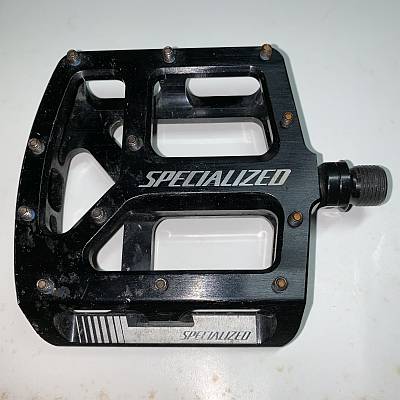 If you are old enough, you probably rode lots of miles before you bought toe clips.
Today, you see far more people riding with "clipless" pedals, especially on road bikes and mountain bikes. What about pedals for bicycle travel?
Why do we care? Which style of pedal is best for traveling cyclists? When I first wrote this
article I was influenced by the popular trend for racing road bikes and mountain bikes. They use clipless pedal.
There is a plastic or metal cleat attaching the shoe to the pedal. The claim has been that bicycling with
clipless pedals made you more effcient. On my bicycle trip across the Northern Tier in 2012, I used clipless mountain bike pedals. In 2014 I did
the same as I pedaled along the pacific coast. Riding the Great Appalacian Passage trail and the C&O in 2015, I decided to try something different.
I mounted my vintage "Low Fat" mountain bike pedals and a brand new pair of Jack Taylor Converse flat soled shoes with a built in arch support.
Theses worked well enough for that 6 day trip and I used them again for cycling the Southern Tier in 2016. Before I reached St. Augustine,
I regretted the decision. By the end of the trip I was making frequent stops to give my feet a rest. Preparing to ride the Great Divide Mountain
Bike Route in 2017 I switched to platform pedals.
If you are old enough, you probably rode lots of miles before you bought toe clips.
Today, you see far more people riding with "clipless" pedals, especially on road bikes and mountain bikes. What about pedals for bicycle travel?
Why do we care? Which style of pedal is best for traveling cyclists? When I first wrote this
article I was influenced by the popular trend for racing road bikes and mountain bikes. They use clipless pedal.
There is a plastic or metal cleat attaching the shoe to the pedal. The claim has been that bicycling with
clipless pedals made you more effcient. On my bicycle trip across the Northern Tier in 2012, I used clipless mountain bike pedals. In 2014 I did
the same as I pedaled along the pacific coast. Riding the Great Appalacian Passage trail and the C&O in 2015, I decided to try something different.
I mounted my vintage "Low Fat" mountain bike pedals and a brand new pair of Jack Taylor Converse flat soled shoes with a built in arch support.
Theses worked well enough for that 6 day trip and I used them again for cycling the Southern Tier in 2016. Before I reached St. Augustine,
I regretted the decision. By the end of the trip I was making frequent stops to give my feet a rest. Preparing to ride the Great Divide Mountain
Bike Route in 2017 I switched to platform pedals.
Two reasons for using platform pedals on the GDMBR were, first the desire to reduce weight. On most of my previous trips I carried shoes to wear at the campsite an on zero mile days. Second, the Great Divide route is mostly gravel and trails with many hike-a-bike sections where you get off and push your bike. Okay, there is a third. I don't like to fall over. When I started riding clipless pedals in the early 1990s, we called it "turning turtle" when you needed to get a foot down and couldn't get your cleat out of the pedal. At 3.5mph up a steep hill, speed is not the issue. For me it is the fear of not being able to get a foot down when I can no longer turn the cranks.
Because bikepacking typically means carrying less gear and therefore less weight I like the solution of having only one pair of shoes. My Sidi Dominator mountain bike shoes weigh 1.66 pound (753 grams). My Merrell hiking shoes with Vibram soles weigh 2.12 pounds (962 grams). It was the right decision for me, considering the hike-a-bike sections. A pair of Crocs is about 0.6 pound (272 grams). You have lots of choices.
Selecting the right pedal and shoe combination is a personal matter. I always ride clipless pedals on my road bike. For bicycle travel, I expect to continue riding with platform pedals. Whatever you decide, test the pedal and shoe combination well before you head out on a transcontinental bicycle trip. Here are some thoughts on pedals and pedal types for you to consider.
Pedaling Efficiency
As a boy and into early adulthood I wore my tennis shoes and later running shoes to ride my bicycle. Proponents of clipless pedals say there are some problems with this approach. The soles of other sport shoes are not very stiff. Take a pair of running shoes and bend them - toe and heel down. You will quickly see how flexible these shoes are. The claim has been that this is not efficient for transferring power to the pedals. Take off your shoe. Look at your foot. You can arch your foot toe and heel down a very small amount. Does it matter that you can flex the shoe without your foot in it? Probably not.
Racing Cyclist will tell you that you will only be able to transmit force to the pedals on the downward stroke. The claim is that you can pull through the bottom of the stroke with clipless cycling pedals. Pulling through is like scraping mud off the bottom of your shoe they say. What really happens? I will write more on this soon. For now I will tell you that I am switching back to flat pedals for my next bicycle tour. I will only have to take one pair of shoes. Walking in grocery stores or trails will be easier. More later.
Toe Clip
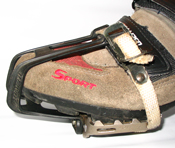 Back in the day, toe clips were popular. The clip keeps your foot from sliding forward as
you push through the circle. The strap keeps your foot securely in place. If you ride with
your straps tight, you have to loosen one, before you come to a stop. I saw a fellow riding last
fall using toe clips on his fixed gear bike.
Back in the day, toe clips were popular. The clip keeps your foot from sliding forward as
you push through the circle. The strap keeps your foot securely in place. If you ride with
your straps tight, you have to loosen one, before you come to a stop. I saw a fellow riding last
fall using toe clips on his fixed gear bike.
Clipless Pedals
SPD Pedals
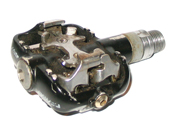 The SPD style pedal, invented by Shimano, used on mountain bikes has the advantage of a small cleat on the
bottom of the shoe that makes walking easy. When you take a break or walk into a store
for some refreshment, this style shoe will be comfortable.
The SPD style pedal, invented by Shimano, used on mountain bikes has the advantage of a small cleat on the
bottom of the shoe that makes walking easy. When you take a break or walk into a store
for some refreshment, this style shoe will be comfortable. 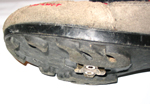 Notice that the cleat is recessed so that it does not contact the floor. This pedal
is one of many newer pedals that are referred to as "clipless" pedals.
Notice that the cleat is recessed so that it does not contact the floor. This pedal
is one of many newer pedals that are referred to as "clipless" pedals.
Eggbeater
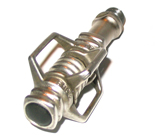 This pedal has four sides for entry. The cleat is similar in size and shape to the
SPD style. I have used this style and even had it on my road bike for a while.
This is also classified as a clipless pedal.
This pedal has four sides for entry. The cleat is similar in size and shape to the
SPD style. I have used this style and even had it on my road bike for a while.
This is also classified as a clipless pedal.
Road Bike Pedals
 Some of the popular road bike pedals are from Shimano, Look and Time. On a cross
country trip the weight of the pedal should be reviewed. From my point of view,
you will also want to look carefully at the cleat. My road bike shoes currently have Look style
cleats. They are not as easy to walk on as the SPD style. You can see in the photo
that the cleat raises the front of your foot. There is a small rubber insert near
the rear of the cleat. It is almost flush after one season. Test the pedals before you
take off on a long trip. Some designs distribute the load better than others. If you are riding on a supported tour where you
don't have to carry your gear and you want a pair of shoes around camp or the motel, road bike shoes will probably work.
Some of the popular road bike pedals are from Shimano, Look and Time. On a cross
country trip the weight of the pedal should be reviewed. From my point of view,
you will also want to look carefully at the cleat. My road bike shoes currently have Look style
cleats. They are not as easy to walk on as the SPD style. You can see in the photo
that the cleat raises the front of your foot. There is a small rubber insert near
the rear of the cleat. It is almost flush after one season. Test the pedals before you
take off on a long trip. Some designs distribute the load better than others. If you are riding on a supported tour where you
don't have to carry your gear and you want a pair of shoes around camp or the motel, road bike shoes will probably work.
On RAGBRAI even with my gear on a truck, I choose to use Sidi Dominator mountain bike shoes for the comfort of walking at the many towns with snacks, food and beverages.
Links of Interest


 United States
United States